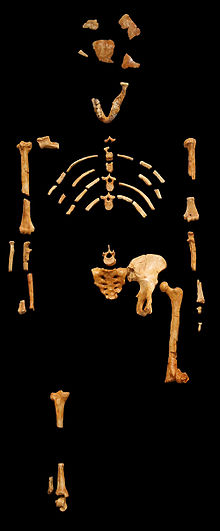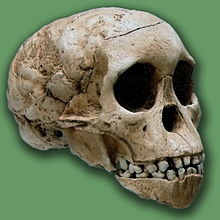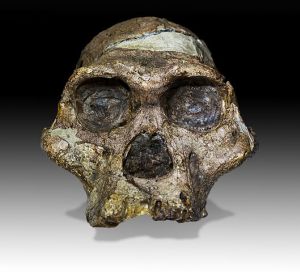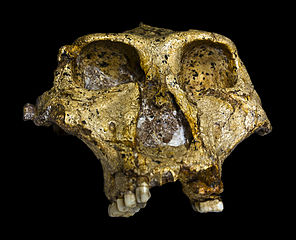| Primates | ||
| The Vertebrates | Hominini |
| Vertebrates Home | Vertebrate | Vertebrate |
|
Abbreviated Dendrogram
Archonta
│
└─Primates
├─Strepsirhini
└─Haplorhini
├─Tarsiiformes
└─Anthropoidea
├─Platyrrhini
└─Hominoidea
├─Hylobatidae
└─Hominidae
├─Ponginae
└─Homininae
├─Gorilla
└─┬─Sahelanthropus
└─┬─Pan
└─Hominini
├─Ardipithecus
└─┬─Australopithecus afarensis
├?─Paranthropus aethiopicus (if descended from A afarensis)
└─┬─Australopithecus africanus
└─┬─Paranthropus
│ ├?─Paranthropus aethiopicus
│ └─┬─Paranthropus robustus
│ └─Paranthropus boisei
└─┬─Kenyanthropus
└─Homo
|
Contents
Overview |
Taxa on This Page
Editor's note: the following is copied verbatum, from Wikipedia, for no other reason than that the current editor has so much work to do in Palaeos that it was felt easiest to just copy n paste. At some point this material will be upgraded, updates, and elaborated upon (hopefully) - MAK111128
The more anthropomorphic primates of the Hominini tribe are placed in the Hominina subtribe. Referred to as hominans, they are characterized by the evolution of an increasingly erect bipedal locomotion. The only extant species is Homo sapiens. Fossil records indicate this subtribe branched from the common ancestor with the chimpanzee lineage about 3 to 5 million years ago.
Current evidence[citation needed] suggests that, about 2.6 million years ago, Australopithecus began to diverge into two paths. One path produced Paranthropus, more robust, specialized in a plant food that required a stronger jaw and molars and powerful facial muscles that required a cranial crest, much like a modern gorilla has, to unite them. The other track led to Homo, with a relatively larger brain, more delicate teeth and jaw. Both genera existed at the same time for about 1 and a half million years.
This subtribe is usually considered to include Australopithecus, Paranthropus, Sahelanthropus, Orrorin, Ardipithecus, Kenyanthropus, and Homo. However, the exact makeup is still under debate, as scientists continue to determine the order of descent in human evolution. - Wikipedia
By rights, this should be a short section. Even in the hands of the more avid splitters currently working on it, the Hominini has never been an overly large clade, and only a single species is still extant. And yet, because of the minor detail that this species happens to be our own, the Hominini continues to receive a great deal of attention.
One side-effect of this high level of interest is that the Hominini have suffered to an extraordinary degree from bad and/or sloppy taxonomy. Almost every species known from more than one fossil individual has accrued a sizeable synonymy, with many available specimens being assigned their own names (both species and genus) at some point, and some single specimens even being assigned multiple names. The tree below attempts some order from the chaos. It presents more of a splitter's perspective on hominin evolution - many species would not be recognised by more conservative workers, some of whom would reduce the genus Homo, for instance, to only three species - Homo habilis, H. erectus and H. sapiens. There is also a considerable degree of debate of how best to treat the paraphyletic series of taxa generally included in the genus Australopithecus (the species between 'Australopithecus' anamensis and Paranthropus robustus in the tree below), with none of the suggested alternatives being really satisfactory.
✶Type species of generic name indicated
References
Asfaw, B., W. H. Gilbert, Y. Beyene, W. K. Hart, P. R. Renne, G. WoldeGabriel, E. S. Vrba & T. D. White. 2002. Remains of Homo erectus from Bouri, Middle Awash, Ethiopia. Nature 416: 317-320.
Brown, P., T. Sutikna, M. J. Morwood, R. P. Soejono, Jatmiko, E. W. Saptomo & R. A. Due. 2004. A new small-bodied hominin from the Late Pleistocene of Flores, Indonesia. Nature 431: 1055-1061.
Brunet, M., F. Guy, D. Pilbeam, H. T. Mackaye, A. Likius, D. Ahounta, A. Beauvilain, C. Blondel, H. Bocherens, J.-R. Boisserie, L. de Bonis, Y. Coppens, J. Dejax, C. Denys, P. Duringer, V. Eisenmann, G. Fanone, P. Fronty, D. Geraads, T. Lehmann, F. Lihoreau, A. Louchart, A. Mahamat, G. Merceron, G. Mouchelin, O. Otero, P. Pelaez Campomanes, M. Ponce de Leon, J.-C. Rage, M. Sapanet, M. Schuster, J. Sudre, P. Tassy, X. Valentin, P. Vignaud, L. Viriot, A. Zazzo & C. Zollikofer. 2002. A new hominid from the Upper Miocene of Chad, central Africa. Nature 418: 145-151.
Cela-Conde, C. J., & F. J. Ayala. 2003. Genera of the human lineage. Proceedings of the National Academy of Sciences of the USA 100 (13): 7684-7689.
Gabounia, L., M.-A. de Lumley, A. Vekua, D. Lordkipanidze & H. de Lumley. 2002. Découverte d'un nouvel hominidé à Dmanissi (Transcaucasie, Géorgie). Comptes Rendus Palevol 1: 243-253.
Groves, C. P. 1999. Nomenclature of African Plio-Pleistocene hominins. Journal of Human Evolution 37: 869-872.
Howell, F. C. 1978. Hominidae. In Evolution of African Mammals (V. J. Maglio & H. B. S. Cooke, eds.) pp. 154-248. Harvard University Press: Cambridge (Massachusetts).
Huang W., R. Ciochon, Gu Y., R. Larick, Fang Q., H. Schwarcz, C. Yonge, J. de Vos & W. Rink. 1995. Early Homo and associated artefacts from Asia. Nature 378: 275-278.
ICZN. 1999. Opinion 1941: Australopithecus afarensis Johanson, 1978 (Mammalia, Primates): specific name conserved. Bulletin of Zoological Nomenclature 56 (3): 223-224.
Kennedy, K. A. R. 1999. Paleoanthropology of South Asia. Evolutionary Anthropology 8 (5): 165-185.
Kennedy, K. A. R., A. Sonakia, J. Chiment & K. K. Verma. 1991. Is the Narmada hominid an Indian Homo erectus? American Journal of Physical Anthropology 86: 475-496.
Lahr, M. M., & R. Foley. 2004. Human evolution writ small. Nature 431: 1043-1044.
Leakey, L. S. B., P. V. Tobias & J. R. Napier. 1964. A new species of the genus Homo from Olduvai Gorge. Nature 202: 7-9.
Lieberman, D. E. 2001. Another face in our family tree. Nature 410: 419-420.
Mallegni, F., E. Carnieri, M. Bisconti, G. Tartarelli, S. Ricci, I. Biddittu & A. Segre. 2003. Homo cepranensis sp. nov. and the evolution of African-European Middle Pleistocene hominids. Comptes Rendus Palevol 2: 153-159.
Pickford, M., B. Senut, D. Gommery & J. Treil. 2003. Bipedalism in Orrorin tugenensis revealed by its femora. Comptes Rendus Palevol 1: 191-203.
Senut, B., M. Pickford, D. Gommery, P. Mein, K. Cheboi & Y. Coppens. 2001. First hominid from the Miocene (Lukeino Formation, Kenya). Comptes Rendus de L'Academie des Sciences – Series IIA – Earth and Planetary Sciences 332: 137-144.
Strait, D. S., & F. E. Grine. 2004. Inferring hominoid and early hominid phylogeny using craniodental characters: the role of fossil taxa. Journal of Human Evolution 47 (6): 349-452.
Stringer, C. 2003. Out of Ethiopia. Nature 423: 692-695.
White, T. D., B. Asfaw, D. DeGusta, H. Gilbert, G. D. Richards, G. Suwa & F. C. Howell. 2003. Pleistocene Homo sapiens from Middle Awash, Ethiopia. Nature 423: 742-747.
White, T. D., Giday WoldeGabriel, Berhane Asfaw, Stan Ambrose, Yonas Beyene, Raymond L. Bernor, Jean-Renaud Boisserie, Brian Currie, Henry Gilbert, Yohannes Haile-Selassie, William K. Hart, Leslea J. Hlusko, F. Clark Howell, Reiko T. Kono, Thomas Lehmann, Antoine Louchart, C. Owen Lovejoy, Paul R. Renne, Haruo Saegusa, Elisabeth S. Vrba, Hank Wesselman and Gen Suwa, 2006. Asa Issie, Aramis and the origin of Australopithecus. Nature 440: 883-889.
White, T. D., G. Suwa & B. Asfaw. 1994. Australopithecus ramidus, a new species of early hominid from Aramis, Ethiopia. Nature 371: 306-312.
Wolpoff, M.H., J. Hawks, B. Senut, M. Pickford, & J. Ahern. An Ape or The Ape: Is The Toumaï Cranium TM 266 a Hominid? PaleoAnthropology 2006:36-50.
Wood, B. 2002. Hominid revelations from Chad. Nature 418: 133-135.
Wood, B., & B. G. Richmond. 2000. Human evolution: Taxonomy and paleobiology. Journal of Anatomy 196: 19-60.
CKT080702 - the Palaeos wiki
Hominini : LCA of Apemen + Men, and all its descendants
Range: from the Latest Miocene. cosmopolitan.
Phylogeny: -Homininae : Samburupithecus + (Gorillini + (Sahelanthropus + (Pan + * : Ardipithecus + (Australopithecus afarensis + (Australopithecus africanus + (Paranthropus + (Kenyanthropus + Homo))))))
Comments: A quite diverse, mostly African group, includes a number of genera, such as Ardipithecus, Australopithecus, Homo, Kenyanthropus, and Paranthropus; Sahelanthropus is sometimes also placed here but we have positionally more basally. "Key features of this group involve various adaptations for living predominantly on the ground rather than on the trees. In particular, it is vertical standing, moving on two legs and the skull placed on top of the vertebral column. The feet are not adapted to grasping and holding unlike the rest of primates, but primarily or solely for bipedal locomotion instead, since the first toe is built robustly and aligned with the other four. The hands have a developed opposable thumb and are quite adept at manipulating objects." - from Wikipedia
Note on terminology: we are using the Linnaean tribe rank Hominini rather than the subtribe Hominina, as the latter ranking is based on matching linnaean hierarchies with cladistic branching points, which is totally impractical (since there would be far more branching points then there would be taxonomic hierarchies. Therefore, gorillas, chimps, and humans are ecah given their own tribe (Gorillini, Panini, and Hominini) within the subfamily Homininae, and the chimp + human clade is left unnamed. Alternatively, and equally authentically orangs and the three african clades can be each given a subfamily, making four subfamilies in thw family Hominidae ,As cladistics is a rank-free system it actually doesn't matter what Linnaean ranks are applied, and it is misleading to try to force the Linnaean system to conform to the totally unrelated cladistic system (ort vice-versa)- MAK120711
Image: Life reconstruction of Australopithecus afarensis, from Australopithecus afarensis a Cosmocaixa, Barcelona, Catalunya., Creative Commons Attribution Share Alike, GNU Free Documentation, via Wikipedia
Ardipithecus A. ramidus, A. kadabba
Range: Latest Miocene to Early Pliocene of East Africa
Phylogeny: Hominini : (Australopithecus afarensis + (Australopithecus africanus + (Paranthropus + (Kenyanthropus + Homo)))) + *
Comments: Pliocene A. ramidus better known. Brain between 300 and 350 cm3. Aboreal, likely bipedal as evidenced by its bowl shaped pelvis, the angle of its foramen magnum and its thinner wrist bones, though its feet were still adapted for grasping rather than walking for long distances. -- adapted from Wikipedia

Australopithecus afarensis Johanson in Hinrichson 1978
Synonyms: Praeanthropus afarensis (Johanson in Hinrichson 1978) (nom. cons.) Australopithecus africanus afarensis; A. africanus aethiopicus Tobias 1980 non Paraustralopithecus aethiopicus Arambourg & Coppens 1968, Homo aethiopicus (Tobias) non Bory de St. Vincent 1825, Meganthropus africanus Weinert 1950 (nom. rej.), *Praeanthropus africanus (type species), H. antiquus Ferguson 1984, Australopithecus antiquus, H. antiquus praegens Ferguson 1989]
Range: Middle Pliocene of Kenya and Ethiopia
Phylogeny: Hominini : Ardipithecus + ((Australopithecus africanus + (Paranthropus + (Kenyanthropus + Homo))) + *)
Comments: Best known for the partial skeleton named Lucy (3.2 million years old) found by Donald Johanson and colleagues, who, in celebration of their find, repeatedly played the Beatles song Lucy in the Sky with Diamonds. Compared to the modern and extinct non-hominine great apes, A. afarensis has reduced canines and molars, although they are still relatively larger than in modern humans. Some Australopithecus afarensis left human-like footprints on volcanic ash in Laetoli, Kenya (Northern Tanzania) which provides strong evidence of full-time bipedalism. Thought to be ancestral to both Australopithecus and -- adapted from Wikipedia
Note on terminology: reassigned to the genus Praeanthropus. However many hominine species are paraphyletic (as are many species in general; i.e. species often evolve into other species), and as the relationships seme to be reasonably clearly worked out, it would be confusing to excessively split the genera and species to preserve cladistic formalism. Therefore we are retaining the original anmes MAK120712
Image: Lucy, the most completely known early hominine; skeleton of female Australopithecus afarensis, cast from Museum national d'histoire naturelle, Paris. Photo by 120, Creative Commons Attribution Share Alike, GNU Free Documentation, via Wikipedia

Australopithecus africanus Dart 1925
Synonyms: Homo africanus; incl. Australopithecus prometheus Dart 1948, A. transvaalensis Broom 1936, *Plesianthropus transvaalensis
Range: Late Pliocene of Southern Africa
Phylogeny: Hominini : Ardipithecus + (Australopithecus afarensis + ((Paranthropus + (Kenyanthropus + Homo)) + *))
Comments: Raymond Dart's discovery of the "Taung child" near Kimberley, South Africa in 1924, revolutionised early understanding of human evolution. Although ape-like, the skull had human traits such as eye orbits, teeth, and, most importantly, the position of the foramen magnum (hole at the base of the skull over the spinal column) indicated an erect human-like posture. Dart correctly understood that the skull must be from an intermediate species between ape and humans, but this was rejected by the scientific community which at that time wasinfluenced by the infamous Piltdown forgery and held that a large cranial capacity must precede bipedal locomotion.. Sir Arthur Keith, a fellow anatomist and anthropologist, suggested that the skull belonged to a young ape, most likely from an infant gorilla. It was not until 20 years later that the public accepted the new genus and that australopithecines were a true member of Homininae. - adapted from Wikipedia. Since then, many other early homine species have been found, most famously "Lucy", but Dart's discovery of the Taung child remains the turning point in paleoanthropology
Dart's theory was supported by Robert Broom. In 1938 Broom classified an adult endocranial cast having a brain capacity of 485 cc, which had been found by G. W. Barlow, as Plesianthropus transvaalensis. On April 18, 1947, Broom and John T. Robinson discovered a complete skull (without upper teeth and mandible) interpreted as belonging to a middle-aged female, while blasting at Sterkfontein. Broom classified it also as Plesianthropus transvaalensis, and it was dubbed Mrs. Ples by Broom's young coworkers. The skull is now thought to have belonged to a young male. Both fossils were later classified as Australopithecus africanus. - from Wikipedia

For many years Australopithecus africanus was the most primitive known hominine, far more arcahic than other species such as Homo erectus and Neanderthal man. We now know that the species is significantly more like modern humans than A. afarensis, with a more human-like cranium and facial features. The lack of facial projection in comparison to apes was noted by Raymond Dart (including from Taung Child), a trait in common with more advanced hominines, although still more prognathic thanHomo. A. afarensis has been found at only four sites in southern Africa: Taung (1924), Sterkfontein (1935), Makapansgat (1948) and Gladysvale (1992). Australopithecines have been found in Savannah environments and likely increased its diet to include meat from scavenging opportunities. An analysis of Australopithecus africanus lower vertebrae suggests that females had changes to support bipedalism even while pregnant. -- adapted from Wikipedia MAK120712
Images: Left, Replica of the Taung Child skull described by Raymond Dart, Photo by José-Manuel Benito Álvarez, Pulic Domain, via Wikipedia. Right: "Mrs. Ples" (more probably male) discovered in Sterkfontein cave, South Africa. Transvaal Museum Pretoria. Photo by José Braga; Didier Descouens, Creative Commons Attribution Share Alike, via Wikipedia
Synonyms: Paraustralopithecus Arambourg & Coppens 1967, Zinjanthropus Leakey 1959
Range: Mid Pliocene to Mid Pleistocene of East Africa
Phylogeny: Hominini : Ardipithecus + (Australopithecus afarensis + (Australopithecus africanus + ((Kenyanthropus + Homo) + *: Paranthropus aethiopicus + (Paranthropus boisei + Paranthropus robustus))))
Comments: robust skulls and teeth. Gorilla-like cranial crests suggest strong muscles of mastication, implying a diet of tough plant matter. Appropriately named "alongside man", this long-lived herbivore co-existed alongside Australopithecus afarensis and early humans, becoming increasingly more specialised, and eventually dying out without leaving descendents
Both Paranthropus and Australopithecus were previously included in the subfamily Australopithecinae, although with hominids being taxonomically downgraded to hominines and cladistics replacing evolutionary systematics, this classification is no longer used. However it can be retained as a generic term for the evolutionary grade of hominines intermediate between Ardipithecus and Homo MAK120712
Paranthropus aethiopicus (Arambourg & Coppens 1968)
Synonyms: *Paraustralopithecus aethiopicus, Australopithecus aethiopicus; incl. A. walkeri Ferguson 1989
Range: Mid Pliocene of Ethiopia and Kenya
Phylogeny: Paranthropus : (Paranthropus boisei + Paranthropus robustus) + *
Comments: Known from a toothless partial mandible from Ethiopia, lower jaw and teeth fragments, and most importantly a skull discovered in 1985 by Alan Walker in West Turkana, Kenya, (known as the "Black Skull" due to the dark coloration of the bone, caused by high levels of manganese), which showed it to be the earliest examples of robust pliocene hominids. As with more specialised forms, there is a large sagittal crest and zygomatic arch. In other respects the features are quite primitive and share many traits with Australopithecus afarensis; which implies that the robust austrolpithicines developed from an afarensis rather than an africanus ancestor. Alternatively, this species may be an unrelated form that evolved robust acharacteristics by convergence. P. aethiopicus is known to have lived in mixed savanna and woodland. - adapted from Wikipedia MAK120712
Image: Model of Paranthropus aethiopicus. Natural History Museum, London. Photo by Nrkpan, Creative Commons Attribution Share Alike, GNU Free Documentation, via Wikipedia

Paranthropus robustus Broom 1938
Synonyms: Australopithecus robustus
Range: Mid Pliocene to Mid Pleistocene of South Africa
Phylogeny: Paranthropus : Paranthropus aethiopicus + (Paranthropus boisei + *)
Comments: P. robustus had a head shaped a bit like a gorilla's with a more massive built jaw and teeth. The teeth were larger and thicker than any gracile australopithecine (Australopithecus africanus). On the skull, a bony ridge is located above from the front to back indicating where the jaw muscles joined. Despite the gorilla-like skulls, these hominines were not very large. P. robustus males may have stood only 1.2m tall and weighed 54 kg while females stood just under 1 meter tall and weighed only 40 kg. The teeth found on P. robustus are almost as large as those of P. boisei. Fossil remains have been found only in South Africa, in Kromdraai, Swartkrans, Drimolen, Gondolin and Coopers. In the cave at Swartkrans, the remains of 130 individuals were discovered. The study made on the dentition of the hominins revealed that the average P. robustus rarely lived past 17 years of age. - From Wikipedia. MAK120712
Image: The original complete skull (without mandible) of a 1,8 million years old Paranthropus robustus (Swartkrans, Gauteng, South Africa. Transvaal Museum Pretoria. Photo by José Braga; Didier Descouens, Creative Commons Attribution Share Alike, via Wikipedia
Paranthropus boisei Leakey 1959)
Synonyms: *Zinjanthropus boisei Leakey 1959, Australopithecus boisei
Range: Late Pliocene to Mid Pleistocene of Tazania and Ethiopia
Phylogeny: Paranthropus : Paranthropus aethiopicus + (Paranthropus robustus + )
Comments: First discovered by anthropologist Mary Leakey on July 17, 1959, at Olduvai Gorge, Tanzania, the well-preserved cranium was dated to 1.75 million years old and had characteristics distinctive of the robust australopithecines. Mary and her husband Louis Leakey classified the find as Zinjanthropus boisei: "Zinj" for the medieval East African region of Zanj, "anthropus" meaning ape or ape-human, and "boisei" for Charles Boise (the anthropologists team's funder at the time). The species was nicknamed "Nutcracker Man" because it has the largest, flattest cheek teeth and the thickest enamel of any known hominin, with the rear molar teeth, over twice as great as is found in modern humans. Today it is included in the genus Paranthropus
As with related species, P. boisei inhabited savannah woodland territories. The skull is highly specialized for heavy chewing and several traits seen in modern day gorillas. The brain volume is quite small, about 500 and 550 cm³, not much larger in comparison than Australopithecus. It was previously thought that large postcanine dentition, thick enamel, robust mandibles, sagittal cresting, flaring zygomatic region are indicative of a diet of tough vegetation such as ground tubers, nuts and seeds. But recent research on molar microwear found a pattern very different than that observed for the more southern species P. robustusand that hard foods were an infrequent part of its diet (Ungar et al 2008). The largest of the robust australopithecines, average adult males weighed 49 kg and stood 1.37 m tall, while females weighed 34 kg and stood 1.24 m tall. - adapted from Wikipedia MAK120712
Image: reconstruction of Paranthropus boisei at Westfälisches Museum für Archäologie, Herne, photograph by Lillyundfreya, Creative Commons Attribution Share Alike, via Wikipedia
Range: Late Pliocene of East Africa
Phylogeny: Hominini : Ardipithecus + (Australopithecus afarensis + (Australopithecus africanus + (Paranthropus + (Homo + *))))
page MAK120712